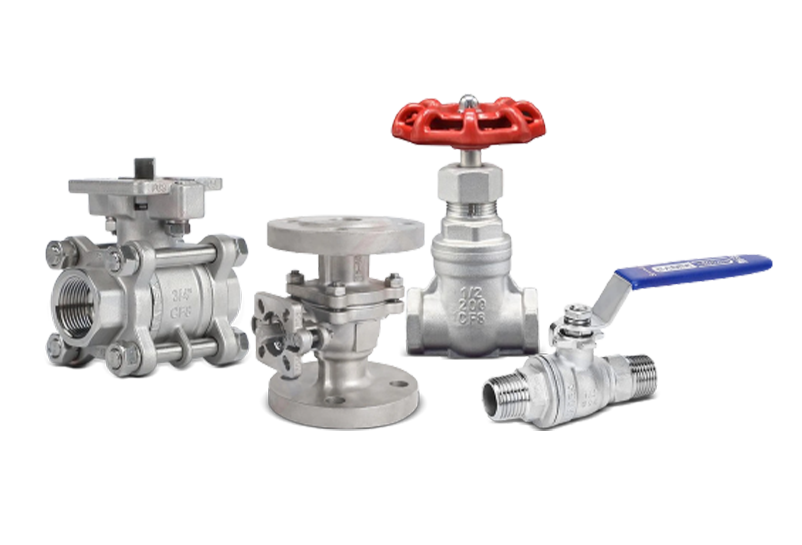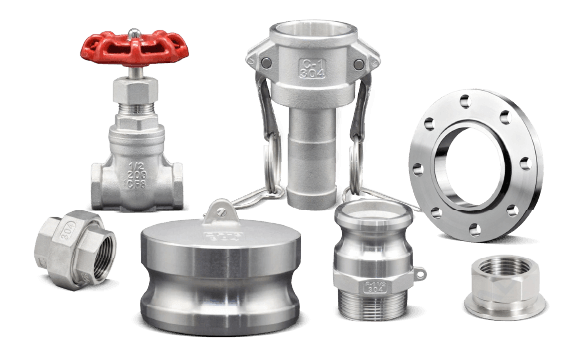Εισαγωγή
Stainless steel valves are the backbone of industrial piping systems, ensuring reliable flow control in demanding environments like chemical plants, food processing facilities, and marine operations. Choosing the right stainless steel grade—304 or 316—can make or break your system’s performance, safety, and longevity. While both grades offer corrosion resistance and durability, their differences in composition and cost impact their suitability for specific applications. In this guide, we explore the benefits of stainless steel valves, compare 304 and 316 grades, and provide practical tips to select the best valve for your needs. Discover why 316’s molybdenum edge or 304’s cost-effectiveness might be the perfect fit for your system.
What Are Stainless Steel Valves?
Stainless steel valves are critical components that regulate, direct, or control the flow of fluids, gases, or slurries in industrial systems. Made from stainless steel alloys, these valves (e.g., ball, gate, check, needle) feature a movable element—like a ball or disc—that opens, closes, or throttles flow. Their robust design ensures durability under high pressure, extreme temperatures, and corrosive conditions.
Why Stainless Steel?
Stainless steel’s unique properties make it a top choice for valves:
- Αντοχή στη διάβρωση: Resists rust and chemical degradation, ideal for harsh environments.
- Ανθεκτικότητα: Withstands high pressures (up to 10,000 PSI for some 316 valves) and temperatures (up to 870°C).
- Hygiene: Non-reactive and easy to clean, meeting FDA standards for food and pharmaceutical applications.
- Ευστροφία: Used across industries like oil and gas, chemical processing, marine, and water treatment.
Common Applications
Stainless steel valves are essential in:
- Χημική Επεξεργασία: Handling acids and corrosive fluids.
- Τρόφιμα και Ποτά: Ensuring sanitary conditions in brewing and dairy production.
- Marine: Resisting saltwater corrosion in desalination and offshore platforms.
- Φαρμακευτικά προϊόντα: Maintaining sterile environments for drug manufacturing.
Learn more about valve types for industrial applications to find the right fit for your system.
Understanding 304 and 316 Stainless Steel Grades
To choose the best stainless steel valve, you need to understand the differences between 304 and 316 grades, which stem from their chemical composition and properties.
304 Stainless Steel
- Composition: 18% chromium, 8% nickel, no molybdenum.
- Properties:
- Good corrosion resistance for mild environments.
- Cost-effective and widely available.
- Ductile, easy to form, and weldable.
- Non-magnetic, suitable for food-safe applications.
- Common Uses: General-purpose valves (e.g., ball valves in water treatment, gate valves in HVAC systems).
316 Stainless Steel
- Composition: 16–18% chromium, 10–14% nickel, 2–3% molybdenum.
- Properties:
- Superior corrosion resistance, especially against chlorides and acids, due to molybdenum.
- Slightly higher tensile strength and durability.
- More expensive (25–40% higher than 304).
- Ideal for harsh environments like marine and chemical settings.
- Common Uses: High-pressure valves (e.g., needle valves in chemical plants, sanitary valves in biopharma).
Key Difference
The addition of 2–3% molybdenum in 316 stainless steel enhances its resistance to pitting and crevice corrosion in chloride-rich environments, making it the go-to choice for marine and chemical applications. 304, while versatile and affordable, is less effective in saline or acidic conditions.
Explore API 600 standards for valve material specifications.
Benefits of Stainless Steel Valves: 304 vs. 316
Both 304 and 316 stainless steel valves offer significant advantages, but their performance varies based on application. Here’s a detailed comparison:
Αντοχή στη διάβρωση
- 304: Provides good corrosion resistance in mild environments, such as water treatment or food processing. It resists rust in indoor or low-chloride settings but may pit in saline conditions.
- Example: 304 ball valves in brewery kettles resist corrosion from water and cleaning agents.
- 316: Excels in chloride-rich environments due to molybdenum, preventing pitting and crevice corrosion in marine, chemical, or coastal applications.
- Example: 316 check valves in offshore oil rigs withstand seawater corrosion, unlike 304, which may degrade over time.
Pressure and Temperature Performance
- 304: Handles moderate pressures (600–1,000 PSI for 1” valves) and temperatures (up to 870°C intermittently). Suitable for general-purpose systems like HVAC or wastewater.
- Example: 304 gate valves in municipal water systems manage low-pressure flows reliably.
- 316: Supports higher pressures (1,000–3,000 PSI) and extreme temperatures (above 843°C), making it ideal for high-pressure chemical or cryogenic applications.
- Example: 316 needle valves in chemical plants regulate high-pressure acid flows safely.
Hygiene and Regulatory Compliance
- Both: FDA-approved for food and pharmaceutical applications due to non-reactivity and cleanability. Both resist bacterial growth, ensuring sanitary conditions.
- 316: Preferred in biopharma and food industries for its superior cleanability and compatibility with clean-in-place (CIP) and sterilize-in-place (SIP) protocols.
- Example: 316 sanitary valves in pharmaceutical plants maintain sterile conditions during drug production.
Cost Considerations
- 304: 25–40% cheaper than 316, ideal for budget-conscious projects with mild operating conditions. Its economies of scale make it widely available.
- Example: 304 ball valves in small-scale water treatment plants reduce upfront costs.
- 316: Higher initial cost but longer lifespan in corrosive environments, reducing replacement and maintenance expenses.
- Example: 316 valves in marine desalination plants offer decades of reliable service, offsetting higher costs.
Check out our valve selection guide to compare 304 and 316 valves for your project.
Choosing the Right Grade for Your Application
Selecting between 304 and 316 stainless steel valves depends on your application’s environmental and operational demands. Here’s how to decide:
Application-Based Selection
- 304: Best for indoor or low-chloride environments, such as:
- Food and beverage (e.g., brewery piping, dairy processing).
- Water treatment (e.g., municipal pipelines).
- HVAC systems (e.g., low-pressure heating loops).
- 316: Ideal for harsh environments, including:
- Marine (e.g., desalination plants, offshore platforms).
- Chemical processing (e.g., acid handling, petrochemical refineries).
- Pharmaceuticals (e.g., sterile drug manufacturing).
Environmental Factors
- Chloride Exposure: Choose 316 for saltwater, coastal, or chloride-rich settings to prevent pitting corrosion.
- Θερμοκρασία: Both grades handle high temperatures, but 316 is better for extreme conditions (e.g., cryogenic or high-heat chemical processes).
- Media Type: For acidic or corrosive fluids, 316’s molybdenum ensures durability; 304 suffices for water or neutral liquids.
Budget vs. Longevity
- 304: Opt for 304 when budget is a priority and corrosion risks are low, minimizing upfront costs.
- 316: Invest in 316 for long-term reliability in harsh environments, reducing maintenance and replacement expenses.
Case Study: Coastal Chemical Plant vs. Dairy Facility
- Coastal Chemical Plant: A chemical plant in Aberdeen, UK, uses 316 stainless steel ball valves to handle sulfuric acid and seawater exposure. The molybdenum content prevents pitting, ensuring a 20-year lifespan.
- Dairy Facility: A dairy processing plant in Wisconsin uses 304 stainless steel gate valves for milk and water pipelines. The low-chloride environment and cost savings justify 304’s use, with minimal maintenance required.
Need help choosing? Contact our valve experts for tailored advice.
Maintenance and Care for Stainless Steel Valves
Proper maintenance extends the lifespan of stainless steel valves, ensuring reliable performance in demanding applications. Here are tailored tips for 304 and 316 grades:
General Maintenance
- Καθάρισμα: Use non-abrasive cleaners to remove residue and prevent corrosion. Avoid harsh chemicals that may damage seals.
- Seal Inspection: Check seals and gaskets every 6–12 months for wear, using a torque wrench to ensure proper seating.
- Actuator Checks: For automated valves, verify actuator calibration quarterly using a multimeter or signal generator.
304-Specific Tips
- Monitor Pitting: In high-humidity environments, inspect for pitting corrosion monthly using a flashlight and inspection mirror.
- Polishing: Polish 304 valve surfaces annually to prevent tarnishing and maintain aesthetics in food processing applications.
316-Specific Tips
- Sanitary Protocols: In biopharma or food settings, follow CIP/SIP protocols, using compatible cleaning agents to maintain hygiene.
- Crevice Corrosion: In marine applications, inspect for crevice corrosion in tight spaces (e.g., valve seats) every 3 months.
Best Practices
- Avoid Abrasives: Use soft brushes or solvent wipes to clean valve surfaces.
- Schedule Inspections: Conduct quarterly visual checks for high-pressure systems to detect leaks or wear early.
- Document Maintenance: Track service history in a computerized maintenance management system (CMMS) to predict failure points.
Download our free valve maintenance checklist to streamline your maintenance routine.
Emerging Trends in Stainless Steel Valves (2025)
As industries evolve, stainless steel valves are adapting to meet modern demands. Here are key trends for 2025:
Smart Valves
- IoT-enabled 304 and 316 valves allow remote monitoring of pressure, flow, and wear, improving efficiency in chemical plants and oil refineries. Sensors detect leaks early, reducing downtime.
Eco-Friendly Designs
- Recyclable 304 valves support sustainable manufacturing, aligning with green initiatives in food and beverage industries. Low-emission seals reduce environmental impact.
3D-Printed Valves
- Custom 316 valves with complex geometries are now 3D-printed for aerospace and pharmaceutical applications, offering precision and reduced lead times.
Stay ahead with our guide to 2025 valve trends.
Συμπέρασμα
Stainless steel valves are essential for reliable flow control, with 304 and 316 grades offering distinct benefits. 304 valves provide cost-effective durability for food processing and water treatment, while 316 valves excel in harsh marine and chemical environments due to their molybdenum-enhanced corrosion resistance. By assessing your application’s media, environment, and budget, you can choose the right grade to optimize performance and longevity. For expert guidance, download our free valve selection checklist or contact our team for a custom quote tailored to your technical needs.
Συχνές ερωτήσεις
- What’s the main difference between 304 and 316 stainless steel valves?
- 316 contains 2–3% molybdenum, enhancing corrosion resistance in chloride-rich environments, while 304 is more cost-effective for milder conditions.
- When should I choose 316 over 304 for my valves?
- Choose 316 for marine, chemical, or pharmaceutical applications with high corrosion risks; use 304 for food processing or low-chloride environments.
- Are 304 stainless steel valves safe for food processing?
- Yes, 304 is FDA-approved, non-reactive, and suitable for food and beverage applications like brewing or dairy.
- How do I maintain stainless steel valves to prevent corrosion?
- Clean regularly with non-abrasive agents, inspect seals every 6–12 months, and monitor 304 valves for pitting in humid conditions.
- What are the cost differences between 304 and 316 valves?
- 316 valves are 25–40% more expensive due to molybdenum and higher nickel content but offer longer lifespans in corrosive environments.


